- Home
- Essential Knots
- Round Turn and Two Half-Hitches
How to Tie the Round Turn & Two Half-Hitches
In a Nutshell...
The Round Turn & Two Half-Hitches is a fundamental knot for any sailor. It's an essential skill for securing a boat to a piling, a dock, or an anchor ring, especially when you need a knot that won't slip under a heavy or constant load. The key takeaway is that the 'round turn' part of the knot takes the majority of the strain, allowing the 'two half-hitches' to be tied securely and easily without the line slipping. This design also makes it surprisingly easy to untie, even after it's been under significant tension for a long time.
Table of Contents
I’ve used countless knots over the years, but few are as dependable for mooring as the Round Turn & Two Half-Hitches. I’ve personally relied on this knot in everything from a calm Mediterranean anchorage to a squally afternoon in the Solent. Its ability to hold fast under pressure while remaining easy to release is a huge advantage, and it’s a skill every sailor should master. Let's get into what makes this knot so useful & how to tie it correctly.
Why Use the Round Turn & Two Half-Hitches?
This knot is a powerhouse because it excels at handling tension. The initial round turn around the object—whether it's a dock cleat, a piling, or an anchor chain—provides a massive amount of friction. This friction is what takes the strain off the final half-hitches, preventing the line from slipping and making the last stage of tying the knot much simpler and safer.
- Secure: The friction from the round turn holds the line in place, making it incredibly secure.
- Reliable: It won't slip, even when the load on the line is heavy or fluctuates with wind and waves.
- Easy to Untie: Because the final half-hitches aren't under significant load, the knot can be untied with relative ease, a huge benefit when you’re in a hurry to get underway.
- Versatile: It's perfect for mooring, tying fenders, or temporarily securing a line.
How to Tie the Round Turn & Two Half-Hitches
Follow these steps to master the knot:
- Step 1: The Round Turn: Wrap the working end of the line completely around the object (a post or cleat). This is the 'round turn' that will absorb most of the strain. For very heavy loads, you can add an extra turn for more friction.
- Step 2: First Half-Hitch: Bring the working end of the line over the standing part and then through the loop you just created. Pull it tight. This is your first half-hitch.
- Step 3: Second Half-Hitch: Repeat the process: bring the working end over the standing part again and through the new loop. Pull it tight against the first half-hitch.
- Step 4: Tighten & Inspect: Pull on the standing part to ensure the knot is secure. The two half-hitches should be snug against each other and the round turn.
Remember, practice is key. Tie the knot a few times on a railing or a chair at home before you rely on it at the dock. The muscle memory will serve you well when you’re out on the water.
So let's look at it again, with illustrations:
For illustration purposes I'm using a rail (well, to be truthful it's a plastic broom handle) rather than a mooring cleat.
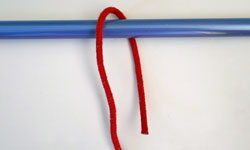
Stage 1
Lay the line over the rail.
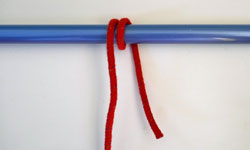
Stage 2
and take a full turn around it.
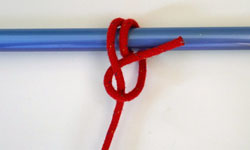
Stage 3
Take the working end around the standing part, making a half-hitch.
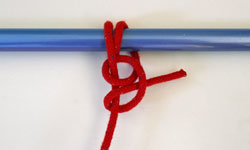
Stage 4
Do the same again, making a second half-hitch. Here we've gone from right to left around the standing part with the second half-hitch, but it's perfectly acceptable to go from left to right.
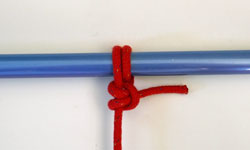
Stage 5
Hold the standing part and pull of the working end and you have the round turn and two half-hitches.
You can now relax in the knowledge that your boat is now securely tied to a plastic broom handle!
What's the Difference Between a Round Turn & a Clove Hitch?
While both knots can be used for similar purposes, they have distinct differences. The Clove Hitch is fast and easy to tie, making it great for temporary lines like fenders. However, it can slip under a heavy, constant load and may jam tight, making it difficult to release. The Round Turn & Two Half-Hitches, on the other hand, is designed specifically for sustained, heavy loads. The round turn adds the necessary friction to prevent slippage, making it the superior choice for permanent mooring lines.
For a complete overview of knots and splicing, including their history and uses, return to our main article: A Sailor's Guide to Essential Knots & Splicing.
By Dick McClary, RYA Yachtmaster Offshore & member of the Yachting Journalists Association (YJA)
Frequently Asked Questions (FAQs)
Can I use this knot for tying fenders?
Can I use this knot for tying fenders?
Yes, the Round Turn & Two Half-Hitches is an excellent choice for fenders because it's secure and easy to adjust.
Is this knot suitable for anchoring?
Is this knot suitable for anchoring?
Absolutely. It's a very common and reliable knot for tying your anchor rode to a cleat or smson post, especially in situations where you might have heavy loads or chafe.
What if the line is under a lot of strain while I’m tying the knot?
What if the line is under a lot of strain while I’m tying the knot?
This is where the 'round turn' shines. The friction it creates holds the line, allowing you to tie the half-hitches with little to no tension on the working end. This makes the process much safer and more reliable.
What's the best way to secure this knot to a piling?
What's the best way to secure this knot to a piling?
The most common method is to make the round turn around the piling itself, then tie the two half-hitches around the standing part of the line.
Sources
- "The Ashley Book of Knots" by Clifford W. Ashley, a comprehensive and authoritative guide.
- "Chapman Piloting & Seamanship", an industry-standard reference for sailors.
- UK Royal Yachting Association (RYA) training materials for 'Competent Crew' & 'Yachtmaster' courses.
Recent Articles
-
Modern Boat Electronics and the Latest Marine Instruments
Dec 20, 25 05:27 PM
Should sailboat instruments be linked to the latest boat electronics as a fully integrated system, or is it best to leave them as independent units? -
Hans Christian 43: Classic Bluewater Cruiser & Liveaboard Sailboat
Dec 10, 25 04:37 AM
Explore the Hans Christian 43: a legendary heavy-displacement, long-keel sailboat. Read our in-depth review of its specs, design ratios, and suitability for offshore cruising and living aboard. -
Planning Your Sailboat Liveaboard Lifestyle: An Ocean Sailor's Guide
Dec 06, 25 05:18 AM
Seasoned sailors share their methodical risk analysis for planning a secure Sailboat Liveaboard Lifestyle, covering financial, property, and relationship risks.












